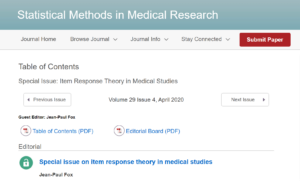Introduction
They are operationalized on a tablet computer, which is simple and convenient in a healthcare setting. With the ever-increasing availability of computer devices (smart devices), computer-assisted assessments are becoming the standard. Together with the increase in data storage opportunities, computer-assisted test administration becomes applicable for clinical trials and longitudinal observational studies. These developments also created new computational, mathematical and statistical challenges. Due to the innovative types of data collection, more and more data are collected with complex dependence structures. To make reliable and accurate decisions from observed data, more general IRT models are needed to account for dependencies that go beyond the well-known data correlations caused by the clustering of item responses within persons and items.

